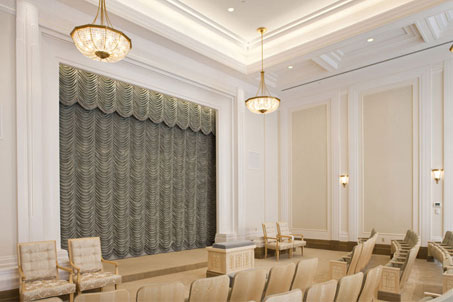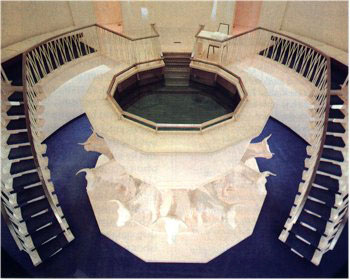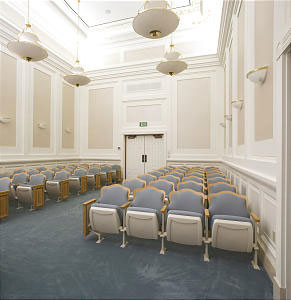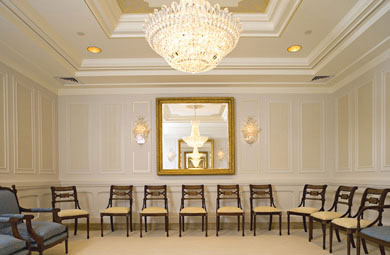The word ritual is defined as follows: :
- Of or relating to rites or a ritual: ceremonial, such as a ritual dance.
- According to religious law, as in ritual purity.
- done in accordance with social custom or normal protocol, as in ritual patterns of movement.
The word ritual derives from the word rite. A rite is defined as follows:
- A prescribed form or manner governing the words or actions for a ceremony.
- The ceremonial practices of a church or group of churches.
 Therefore, a ritual is, by nature, repetitive. It’s something that is done the same way every time. Thus, all churches have rituals — the way the Eucharist is offered to the congregants, the way a meeting is organized. There is no negative connotation to the word “ritual.”
Therefore, a ritual is, by nature, repetitive. It’s something that is done the same way every time. Thus, all churches have rituals — the way the Eucharist is offered to the congregants, the way a meeting is organized. There is no negative connotation to the word “ritual.”
In Mormon Sunday meetings the sacrament — the representation of the body and blood of Christ, as bread and water — is blessed and passed by holders of the Aaronic Priesthood in an orderly way. This is a ritual. The Mormon Temple rituals are always the same, with recitations that do not change.
Mormon Temple Ritual
 There are several rituals that take place in Mormon temples. The first is baptism for the dead. Baptism by immersion is a simple ritual. In the temple, baptisms for the dead are performed by “elders” who hold the higher, or Melchizedek Priesthood. The words are…”(the person’s name), by the power and authority of the holy priesthood which I hold, I baptize you in the name of the Father, and the Son, and the Holy Ghost, Amen.” This is a very simple ritual. It’s always the same. The person being baptized must be completely immersed in the water. Mormons are actually baptized outside the temple for themselves, and inside temples for the deceased. A person receives following ordinances in the temple just once for him- or herself, and then ever after for the deceased.
There are several rituals that take place in Mormon temples. The first is baptism for the dead. Baptism by immersion is a simple ritual. In the temple, baptisms for the dead are performed by “elders” who hold the higher, or Melchizedek Priesthood. The words are…”(the person’s name), by the power and authority of the holy priesthood which I hold, I baptize you in the name of the Father, and the Son, and the Holy Ghost, Amen.” This is a very simple ritual. It’s always the same. The person being baptized must be completely immersed in the water. Mormons are actually baptized outside the temple for themselves, and inside temples for the deceased. A person receives following ordinances in the temple just once for him- or herself, and then ever after for the deceased.
After being baptized by proxy for a deceased ancestor, the temple patron will go through another ritual, that of receiving the Holy Ghost on behalf of the ancestor. The Holy Ghost is conferred by the laying on of hands by a man holding the higher priesthood. Remember in the New Testament, the apostles encountered baptized Christians who had not received the Holy Ghost by the laying on of hands. They performed the ordinance, which is meant to follow baptism.
The next Mormon temple ritual is commonly called the “initiatory.” Mormons will sometimes say, “I’m going to the temple to do intitiatories.” Again, this is work for their deceased ancestors. The initiatory is a symbolic washing and anointing, which always preceded temple service in ancient times. The ordinances of the initiatory are so symbolic, that only a drop of water and drop of oil are used. This is a ritual that typifies purifying oneself for temple service.
 The next Mormon temple ritual is the “endowment.” An endowment is a gift, and this ritual (which lasts about an hour and a half) endows participants with power from on high in order to cope with the challenges of life. It also prepares temple patrons for the receipt of more and more knowledge through inspiration from Christ through the Holy Ghost. Again, the endowment is always the same. Some people accuse Mormons of practicing all sorts of unholy rites in the temple, even sexual rites. This is amazing for Mormons. At the beginning of every endowment session, there is a counsel to stay awake and alert. It’s easy to fall asleep. If all sorts of devilish things were going on in the temple, Mormons might not have a problem staying awake.
The next Mormon temple ritual is the “endowment.” An endowment is a gift, and this ritual (which lasts about an hour and a half) endows participants with power from on high in order to cope with the challenges of life. It also prepares temple patrons for the receipt of more and more knowledge through inspiration from Christ through the Holy Ghost. Again, the endowment is always the same. Some people accuse Mormons of practicing all sorts of unholy rites in the temple, even sexual rites. This is amazing for Mormons. At the beginning of every endowment session, there is a counsel to stay awake and alert. It’s easy to fall asleep. If all sorts of devilish things were going on in the temple, Mormons might not have a problem staying awake.
The endowment ritual takes place in an ordinance room, or endowment room. Most Mormon temples have several, and sessions begin every half hour. The endowment room looks like a pristinely and beautifully decorated auditorium. There is instruction included in the endowment session which includes an account of the creation and fall of Adam, and the basic and higher commandments of God. Patrons symbolically progress from mortality to the celestial kingdom — the highest kingdom of heaven. This is the culmination of the session, when patrons leave the endowment room and enter the celestial room, the most beautiful room in the temple.
Temple Sealings
 Another room in a Mormon temple is the “sealing room,” wherein another Mormon temple ritual takes place. A Mormon temple sealing room has an altar in the center, and chairs around the periphery of the room for guests. Large mirrors on the walls face each other to reflect the couple’s image to infinity. Here, worthy couples make eternal marriage vows. Bride and groom kneel facing one another and hold hands across the altar to say their vows. Marriage vows are for eternity, but this depends on continued worthiness and fidelity in marriage.
Another room in a Mormon temple is the “sealing room,” wherein another Mormon temple ritual takes place. A Mormon temple sealing room has an altar in the center, and chairs around the periphery of the room for guests. Large mirrors on the walls face each other to reflect the couple’s image to infinity. Here, worthy couples make eternal marriage vows. Bride and groom kneel facing one another and hold hands across the altar to say their vows. Marriage vows are for eternity, but this depends on continued worthiness and fidelity in marriage.
Bride and groom may exchange rings after they say their vows, but this is not a formal part of the Mormon temple ritual. Most couples do exchange rings at this time, but some have a ring ceremony as part of their wedding reception, especially for the sake of family members not able to attend the temple sealing.
If a couple has children, but have never been sealed together, then the children are also brought into the sealing room. Everyone in the family is dressed in white. The children are sealed eternally to the parents, after the couple are sealed, one to the other. When children are born to a previously sealed couple, they are considered “born in the covenant,” and they don’t need a future temple sealing to their parents.
Rumors About the Mormon Temple Ritual
Rumors abound about the Mormon temple rituals. There is absolutely nothing devilish or sexual that goes on in Mormon temples. Purity and chastity are mandatory for entering the temple, and these values are certainly upheld inside the temple. There is also nothing in the film about the creation of the earth and fall of Adam and Eve that is untoward.
